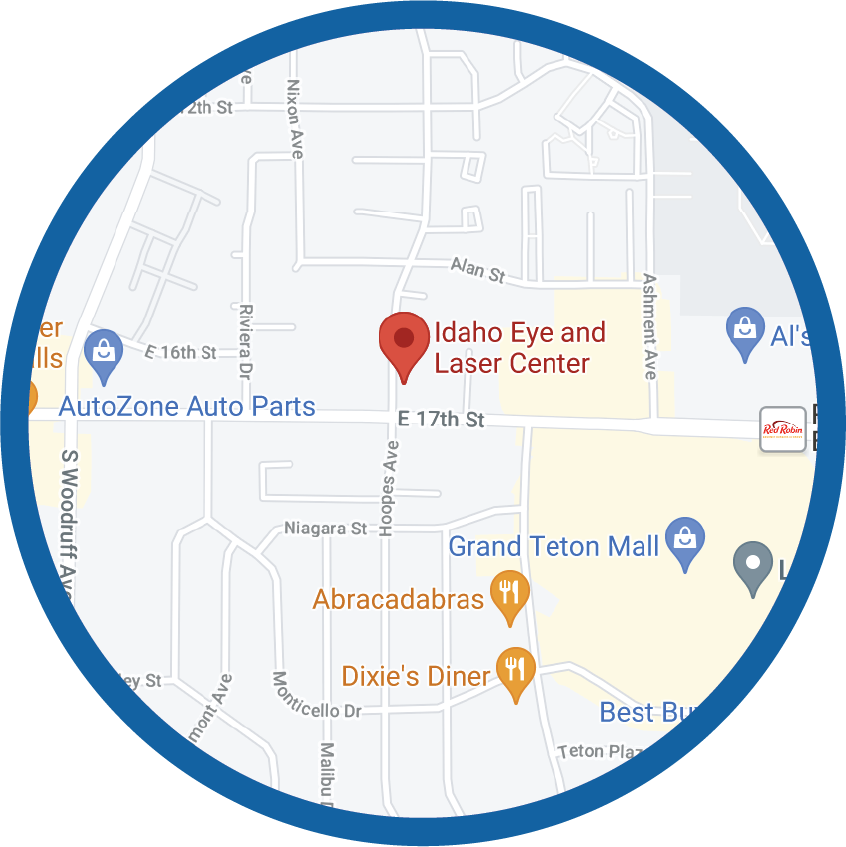Corneal Cross-linking
If you suffer from keratoconus, your wait for progressive treatment is finally over. The FDA has approved corneal cross-linking (KXL) to strengthen weak corneas caused by keratoconus – and ultimately save vision. It may also reduce the need for corneal transplants for some patients.
At the Idaho Eye and Laser Center, we are proud to be the only practice in Southeast Idaho to offer keratoconus patients corneal cross-linking in Idaho Falls: the iLink™ procedure. iLink is the only FDA-approved corneal cross-linking procedure for the treatment of keratoconus.
How KXL Works
During this minimally-invasive outpatient procedure, the thin outer layer of the eye’s surface is removed. Then we apply a riboflavin solution (a form of vitamin B2) to the eye, followed by ultraviolet A light exposure. This procedure can make the cornea stronger, more stable and able to hold its shape.
Deeper Explanation of the Riboflavin and UV Process
Specially formulated pharmaceutical-strength riboflavin eye drops called Photrexa® (riboflavin 5’-phosphate ophthalmic solution) and Photrexa® Viscous (riboflavin 5’-phosphate in 20% dextran ophthalmic solution) help enable the cross-linking reaction.
iLink corneal cross-linking applies an artificial source of UV light from a machine called the KXL® System once the cornea has been soaked in the Photrexa and Photrexa Viscous eye drops. This process works to stiffen the cornea by increasing the number of molecular bonds (cross-links) in the collagen. A single treatment may be all that is needed to improve vision.

Less Cross-Linking (Weaker) More Cross-Linking (Stronger)
What to Expect During the Procedure
You will be asked to stop wearing contact lenses prior to surgery for several weeks.
- Your doctor will apply topical anesthesia to numb your eye.
- The epithelium (the thin layer on the surface of the cornea) is gently removed. This process helps prepare your eye so that the drug can penetrate the tissue of the cornea.
- Photrexa® Viscous eye drops will be applied to the cornea for at least 30 minutes.
- Depending on the thickness of your cornea, Photrexa® drops may also be required.
- The cornea is then exposed to UV light for 30 minutes while additional Photrexa® Viscous drops are applied.
- Immediately following treatment, a bandage contact lens is placed on the surface of the eye to protect the newly treated area.
You will remain awake during the treatment. If you are feeling anxious, we may provide you with relaxation medication. The actual procedure takes about an hour, but you will be at the office for approximately two hours to allow sufficient time for preparation and recovery before you return to the comfort of your own home.
What to Expect After the Procedure
- You should not rub your eyes for the first five days after the procedure.
- You may notice a sensitivity to light and an uncomfortable sensation in the treated eye. Sunglasses may help with light sensitivity.
- If you experience severe pain in the eye or any sudden decrease in vision, you should contact your physician immediately.
- If your bandage contact lens from the day of treatment falls out or becomes dislodged, you should not replace it. Contact your physician immediately.
- You may not be allowed back into contact lenses for up to one month.
Does it hurt?
There is some discomfort during immediate recovery but usually not during the treatment. After the numbing drops wear off, there is some discomfort, often described as a gritty, burning sensation that can be managed with acetaminophen and artificial tears. If pain is severe, oral narcotic medications may be prescribed.
Is iLink Covered by Insurance?
The medical necessity of iLink has become widely recognized. As a result, commercial insurance coverage for the procedure is now over 95% in the United States.
Potential Side Effects of iLink Corneal Cross-linking
- Haze (corneal opacity)
- Inflammation (punctate keratitis)
- Fine white lines (corneal striae)
- Disruption of surface cells (corneal epithelium defect)
- Eye pain
- Reduced sharpness of vision (visual acuity)
- Blurred vision
- Ulcerative keratitis, a potentially serious eye infection
The safety and effectiveness of corneal cross-linking has not been established in pregnant women, women who are breastfeeding, patients who are younger than 14 years of age and patients 65 years of age or older.
While not a cure for the disease, this keratoconus treatment has been effective in slowing the progression of the disease and helping preserve vision. Some patients may still need to wear prescription glasses or contact lenses to achieve their best vision possible. There is no change in the appearance of your eyes following an iLink procedure.
If you have been diagnosed with keratoconus, contact us today to schedule an eye exam with our keratoconus doctors in Idaho Falls and learn about this innovative treatment option.




